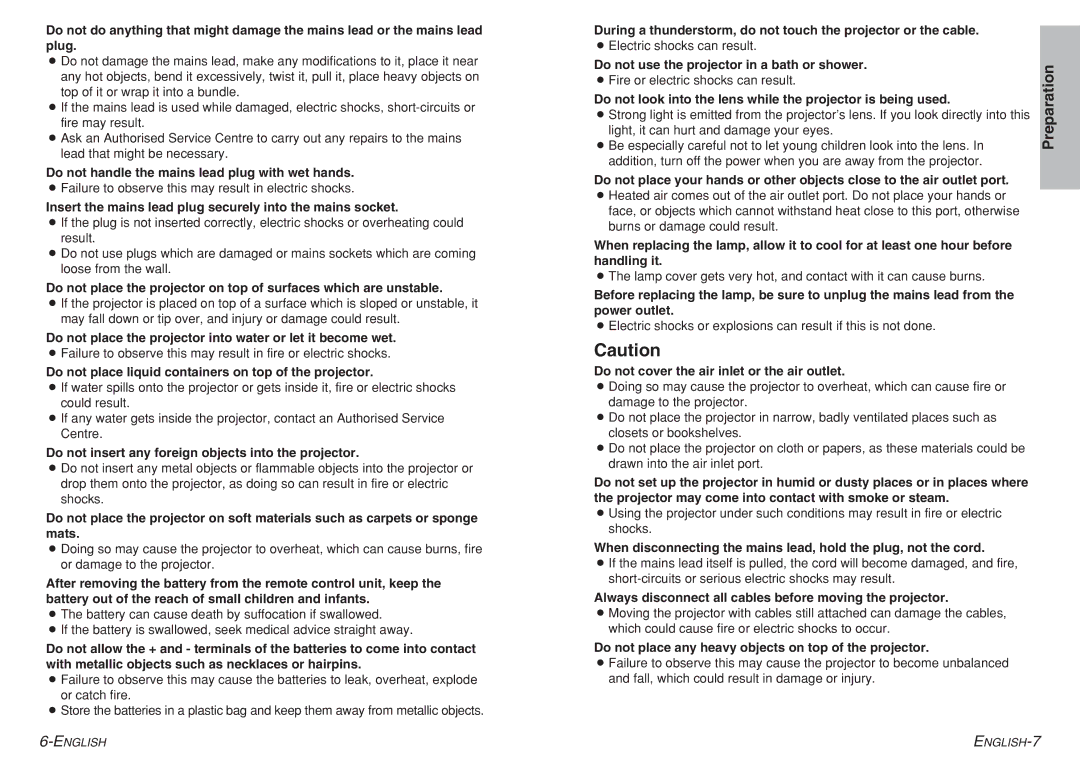Do not do anything that might damage the mains lead or the mains lead plug.
BDo not damage the mains lead, make any modifications to it, place it near any hot objects, bend it excessively, twist it, pull it, place heavy objects on top of it or wrap it into a bundle.
BIf the mains lead is used while damaged, electric shocks,
BAsk an Authorised Service Centre to carry out any repairs to the mains lead that might be necessary.
Do not handle the mains lead plug with wet hands.
BFailure to observe this may result in electric shocks.
Insert the mains lead plug securely into the mains socket.
BIf the plug is not inserted correctly, electric shocks or overheating could result.
BDo not use plugs which are damaged or mains sockets which are coming loose from the wall.
Do not place the projector on top of surfaces which are unstable.
BIf the projector is placed on top of a surface which is sloped or unstable, it may fall down or tip over, and injury or damage could result.
Do not place the projector into water or let it become wet.
BFailure to observe this may result in fire or electric shocks.
Do not place liquid containers on top of the projector.
BIf water spills onto the projector or gets inside it, fire or electric shocks could result.
BIf any water gets inside the projector, contact an Authorised Service Centre.
Do not insert any foreign objects into the projector.
BDo not insert any metal objects or flammable objects into the projector or drop them onto the projector, as doing so can result in fire or electric shocks.
Do not place the projector on soft materials such as carpets or sponge mats.
BDoing so may cause the projector to overheat, which can cause burns, fire or damage to the projector.
After removing the battery from the remote control unit, keep the battery out of the reach of small children and infants.
BThe battery can cause death by suffocation if swallowed.
BIf the battery is swallowed, seek medical advice straight away.
Do not allow the + and - terminals of the batteries to come into contact with metallic objects such as necklaces or hairpins.
BFailure to observe this may cause the batteries to leak, overheat, explode or catch fire.
BStore the batteries in a plastic bag and keep them away from metallic objects.
During a thunderstorm, do not touch the projector or the cable.
BElectric shocks can result.
Do not use the projector in a bath or shower.
BFire or electric shocks can result.
Do not look into the lens while the projector is being used.
BStrong light is emitted from the projector’s lens. If you look directly into this light, it can hurt and damage your eyes.
BBe especially careful not to let young children look into the lens. In addition, turn off the power when you are away from the projector.
Do not place your hands or other objects close to the air outlet port.
BHeated air comes out of the air outlet port. Do not place your hands or face, or objects which cannot withstand heat close to this port, otherwise burns or damage could result.
When replacing the lamp, allow it to cool for at least one hour before handling it.
BThe lamp cover gets very hot, and contact with it can cause burns.
Before replacing the lamp, be sure to unplug the mains lead from the power outlet.
BElectric shocks or explosions can result if this is not done.
Caution
Do not cover the air inlet or the air outlet.
BDoing so may cause the projector to overheat, which can cause fire or damage to the projector.
BDo not place the projector in narrow, badly ventilated places such as closets or bookshelves.
BDo not place the projector on cloth or papers, as these materials could be drawn into the air inlet port.
Do not set up the projector in humid or dusty places or in places where the projector may come into contact with smoke or steam.
BUsing the projector under such conditions may result in fire or electric shocks.
When disconnecting the mains lead, hold the plug, not the cord.
BIf the mains lead itself is pulled, the cord will become damaged, and fire,
Always disconnect all cables before moving the projector.
BMoving the projector with cables still attached can damage the cables, which could cause fire or electric shocks to occur.
Do not place any heavy objects on top of the projector.
BFailure to observe this may cause the projector to become unbalanced and fall, which could result in damage or injury.
